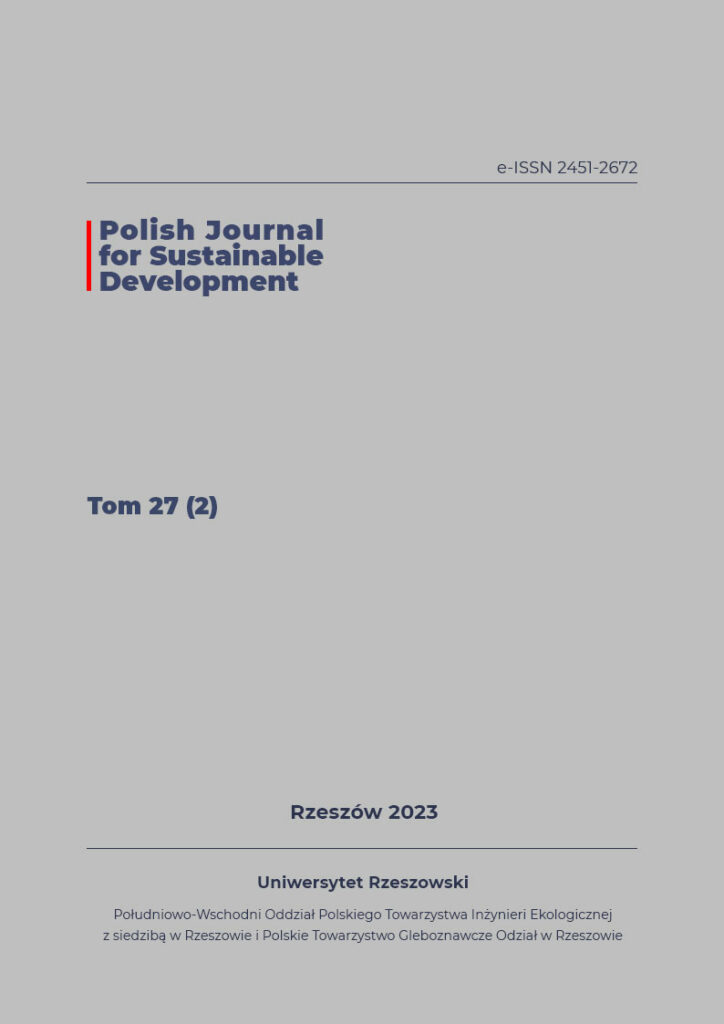Nano- and microplastics – pollution of the 21st century
DOI:
https://doi.org/10.15584/pjsd.2023.27.2.7Keywords:
nanoplastic, microplastic, plastic, environmentAbstract
Plastics are an important material in our economy and everyday life. Thanks to low production costs and the ability to form them into various shapes, they have become the most universal material in the world. Plastics are mass-produced for applications in packaging, construction, electrical and electronics, textiles, transportation and agriculture. Global plastic production in 2021 amounted to 391 million tonnes. As a result of physical, biological, chemical or thermal processes, these materials decompose, forming particles called microplastics (MP) and/or nanoplastics (NP), which have become a significant environmental pollutant in the last decade. These xenobiotics are found in the air, water, soil, as well as in living organisms. They may also cause adverse effects on human health.
Downloads
References
A Technical Report. Chemicals in Plastics. 2023. United Nations Environment Programme and Secretariat of the Basel, Rotterdam and Stockholm Conventions. [https://wedocs.unep.org/bitstream/handle/20.500.11822/42366/Chemicals-in-Plastics. pdf?sequence=1&isAllowed=y; data wejścia 27.11.2023].
Abbasi S., Turner A. 2021. Human exposure to microplastics: a study in Iran. J. Hazard Mater. 403123799. doi:https://doi.org/10.1016/j.jhazmat.2020.123799.
Amato-Lourenço L.F., Carvalho-Oliveira R., Ribeiro Júnior G., dos Santos Galvão L., Ando R.A. Mauad T. 2021. Presence of airborne microplastics in human lung tissue. J. Hazard Mater. 416126124. doi:10.1016/j.jhazmat.2021.126124.
Brun NR., Beenakker M.M.T., Hunting E.R., Ebert D., Vijver M.G. 2017. Brood Pouch-Mediated Polystyrene Nanoparticle Uptake during Daphnia Magna Embryogenesis. Nanotoxicology. 11 (8). 1059-1069. doi: 10.1080/17435390.2017.1391344.
Chamas A., Moon H., Zheng J., Qiu Y., Tabassum T., Jang J.H., Abu-Omar M., Scott S.L., Suh S. 2020. Degradation Rates of Plastics in the Environment. ACS Sustainable Chem. Eng. 8 (9). 3494-3511. doi: https://doi.org/10.1021/acssuschemeng.9b06635.
Cox K.D., Covernton G.A., Davies H.L., Dower J.F., Juanes F., Dudas S.E. 2019. Human consumption of microplastics. Environ. Sci. Technol. 53. 7068-7074. doi: https://doi.org/10.1021/acs.est.9b01517.
Cui R., Kim SW., An Y.J. 2017. Polystyrene Nanoplastics Inhibit Reproduction and Induce Abnormal Embryonic Development in the Freshwater Crustacean Daphnia Galeata. Sci. Rep. 7. 12095. doi: https://doi.org/10.1038/s41598-017-12299-2.
Dacewicz E., Bergel T., Łobos-Moysa E., Moraczewska-Majkut K., Nocoń W. 2021. Mikroplastik i mezoplastik w zastoiskach wód Wisły na obszarach silnie zurbanizowanych powiatu krakowskiego – badania wstępne. Acta Sci. Pol., Formatio Circumiectus. 20 (3/4). 5-17.
Das P., Mandal S., Bhagabati S., Akhtar M., Singh S. 2012. Important Live Food Organisms and Their Role in Aquaculture. [w:] Sundaray J., Sukham M., Mohanty R., Otta S. (red.), Frontiers in Aquaculture. Narendra Publishing House. New Delhi. 69-86.
DYREKTYWA PARLAMENTU EUROPEJSKIEGO I RADY (UE) 2019/904 z dnia 5 czerwca 2019 r. w sprawie zmniejszenia wpływu niektórych produktów z tworzyw sztucznych na środowisko. Dziennik Urzędowy Unii Europejskiej L 155/1. 1-19.
Iheanacho S., Ogbu M., Bhuyan M.S., Ogunji J. 2023. Microplastic Pollution: An Emerging Contaminant in Aquaculture. Aquaculture and Fisheries. 8. 603-616. doi: https://doi.org/10.1016/j.aaf.2023.01.007.
Ivleva N.P., Wiesheu A.C., Niessner R. 2017. Microplastic in Aquatic Ecosystems. Angewandte Chemie International Edition. 56 (7). 1720-1739. doi: 10.1002/anie.201606957.
Makhdoumi P., Hossini H., Pirsaheb M. 2023. A Review of Microplastic Pollution in Commercial Fish for Human Consumptio. Rev Environ Health. 38 (1). 97-109. doi:10.1515/reveh-2021-0103.
Miloloža M., Bule K., Ukić Š., Cvetnić M., Bolanča T., Kušić H., Bulatović V.O., Grgić D.K. 2021. Ecotoxicological Determination of Microplastic Toxicity on Algae Chlorella Sp.: Response Surface Modeling Approach. Water Air Soil Pollut. 232. 327. doi: https://doi.org/10.1007/s11270-021-05267-0.
Nagalakshmaiah M., Afrin S., Malladi R.P., Elkoun S., Robert M., Ansari M., Svedberg A., Karim Z. 2019. Biocomposites: Present trends and challenges for the future. In: Green Composites for Automotive Applications. Elsevier. 197-215.
Napper I.E., Davies B.F.R., Clifford H, Elvin S., Koldewey H.J., Mayewski P.A., Miner K.R., Potocki M., Elmore A.C., Gajurel A.P., Thompson R.C. 2020. Reaching New Heights in Plastic Pollution-Preliminary Findings of Microplastics on Mount Everest. One Earth. 3 (5). 621-630. doi: https://doi.org/10.1016/j.oneear.2020.10.020.
Nocoń W., Moraczewska-Majkut K., Wiśniowska E., Pałka M. 2018. Mikroplastik w wodzie – stopień zanieczyszczenia i zagrożenia związane z obecnością tych mikrozanieczyszczeń. Technologia Wody. 60. 24-29.
Parolini M., Stucchi M., Ambrosini R., Romano A. 2023. A Global Perspective on Microplastic Bioaccumulation in Marine Organisms. Ecological Indicators. 149. 110179. doi: https://doi.org/10.1016/j.ecolind.2023.110179.
Phuong N.N., Zalouk-Vergnoux A., Poirier L., Poirier L., Kamari A., Châtel A., Mouneyrac C., Lagarde F. 2016. Is there any consistency between the microplastics found in the field and those used in laboratory experiments? Environ. Pollut. 211. 111-123. doi: https://doi.org/10.1016/j.envpol.2015.12.035.
Podbielska M., Szpyrka E. 2023. Microplastics – An Emerging Contaminants for Algae. Critical Review and Perspectives. Sci. Total Environ. 885. 163842. doi: https://doi.org/10.1016/j.scitotenv.2023.163842.
Ragusa A., Svelato A., Santacroce C., Catalano P., Notarstefano V., Carnevali O., Papa F., Rongioletti M.C. A., Baiocco F., Draghi S., D'Amore E., Rinaldo D., Matta M, Giorgini E. 2021. Plasticenta: first evidence of microplastics in human placenta. Environ. Int. 106274. doi: https://doi.org/10.1016/j.envint.2020.106274.
ROZPORZĄDZENIE KOMISJI (UE) 2023/2055 z dnia 25 września 2023 r. zmieniające załącznik XVII do rozporządzenia (WE) nr 1907/2006 Parlamentu Europejskiego i Rady w sprawie rejestracji, oceny, udzielania zezwoleń i stosowanych ograniczeń w zakresie chemikaliów (REACH) w odniesieniu do mikrocząstek polimerów syntetycznych. Dziennik Urzędowy Unii Europejskiej. L 238/67. 1-22.
Schmitt-Jansen M., Lips S., Schäfer H., Rummel C. 2020. Microplastic – A New Habitat for Biofilm Communities. In: Rocha-Santos T., Costa M., Mouneyrac C. (eds) Handbook of Microplastics in the Environment. Springer. Cham. doi: https://doi.org/10.1007/978-3-030-10618-8_22-1.
Schwabl P., Köppel S., Königshofer P., Bucsics T., Trauner M., Reiberger T., Liebmann B. 2019. Detection of various microplastics in human stool: a prospective case series. Ann. Intern. Med. 171 (7). 453-457. doi: 10.7326/M19-0618.
Soursou V., Campo J., Picó Y. 2023. A critical review of the novel analytical methods for the determination of microplastics in sand and sediment samples. TrAC Trends in Analytical Chemistry. 166. 117190. doi: https://doi.org/10.1016/j.trac.2023.117190.
Statista 2023. Annual production of plastics worldwide from 1950 to 2021. [https://www.statista.com/statistics/282732/global-production-of-plastics-since-1950/; data wejścia 27.11.2023].
Yan Z., Zhao H., Zhao Y., Zhu Q., Qiao R., Ren H., Zhang Y. 2020. An efficient method for extracting microplastics from feces of different species. J. Hazard. Mater. 384. 121489. doi: https://doi.org/10.1016/j.jhazmat.2019.121489.
Downloads
Published
Issue
Section
License
Copyright (c) 2023 Polish Journal for Sustainable Development

This work is licensed under a Creative Commons Attribution-NonCommercial-NoDerivatives 4.0 International License.


